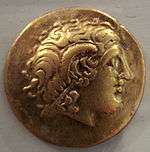Segovellauni
The Segovellauni (Gaulish: "chiefs-of-victory") were a small Gallic tribe, dwelling in the modern Drôme département during the Roman period.[1]
Name
They are mentioned as Sengalaunoì (Σεγγαλαυνοὶ; var. σεταλλανοι) by Ptolemy (2nd c. AD).[2] A regio... Segovellaunorum is also attested by Pliny (1st c. AD).[3][4]
The name Segovellauni ('chiefs-of-victory') stems from Gaulish sego- ('victory') attached to uellaunos ('chief, commandant').[5]
Geography
The territory of the Segovellauni was located between the Rhône and the Drôme rivers.[1] They were in control of a section of the Isère river mouth, from which they held the Allobroges at bay.[6] The Segovellauni nonetheless lived as clients of the neighbouring Cavares.[6]
After the Roman conquest of the region, they were incorporated into the civitas Valentinorum (or colonia Valentia), founded under Caesar or Augustus.[1] A border land around Valentia (Valence) was probably detached from the territory of the Cavares and given to the smaller Segovellauni by the Romans, since Pliny (1st c. CE) described the settlement as in agro Cavarum, whereas Ptolemy (2nd c. CE) had it belonging to the Segovellauni.[7]
References
- Spickermann 2006.
- Ptolemy. Geōgraphikḕ Hyphḗgēsis, 2:10:7
- Pliny. Naturalis Historia, 3:34
- Falileyev 2010, p. entry 4039.
- Delamarre 2003, p. 311.
- Dyson 1985, p. 139.
- Dyson 1985, p. 155.
Bibliography
- Delamarre, Xavier (2003). Dictionnaire de la langue gauloise: Une approche linguistique du vieux-celtique continental (in French). Errance. ISBN 9782877723695.CS1 maint: ref=harv (link)
- Dyson, Stephen L. (1985). The Creation of the Roman Frontier (2014 ed.). Princeton University Press. ISBN 978-1-4008-5489-9.CS1 maint: ref=harv (link)
- Falileyev, Alexander (2010). Dictionary of Continental Celtic Place-names: A Celtic Companion to the Barrington Atlas of the Greek and Roman World. CMCS. ISBN 978-0955718236.
- Spickermann, Wolfgang (2006). "Segovellauni". Brill’s New Pauly.CS1 maint: ref=harv (link)
